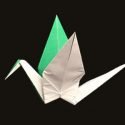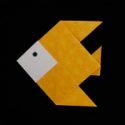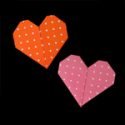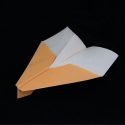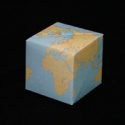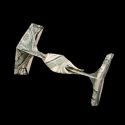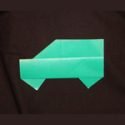Origami Tessellations
Before you read about origami tessellations, do you know what is a tessellation? If not, please read this section first.

Origami tessellation may have been started by Shuzo Fujimoto in the late 1960’s. He self-published a few books with origami tessellation examples in them and in 1976, Fujimoto’s “Solid Origami” was the first commercially published book containing origami tessellaions. Artists including Chris Palmer, Tom Hull, Helena Verrill, and others have developed the art form further. Today, you can see a wide selection of origami tessellations in many Flickr photo sites. More information about the history of origami tessellations can be found in David Listers’ essays on Paper Tessellations and their Diagrams.
Method 1:
Unlike traditional origami, origami tessellations are not made in a linear step-by-step fashion. There are very few instructions on how to fold an origami tessellation and the way you fold is a matter of personal preference.
One method is to:
- Drawn or print a crease pattern onto a piece of paper.
- Crease the paper with mountain and valley folds.
- fold the pre-creased paper into the final shape.
Method 2:
Another method is to fold an entire sheet of paper into a a grid and then create a model from this grid of creases. When folding the pre-creased paper into the final model, it sometimes works best to start from the center of the paper and work outwards. Alternatively, begin working from one edge of the paper and extend towards the opposite edge.
Often, the pre-creased paper needs to be jiggled and tugged to coerce it into its final shape. Three words of advice: patience, practice, and perseverance.

- Read about Rikki Donachie’s first tessellation which took 3 hours of creasing and over 4 hours of paper-coercion.
- Eric Gjerde’s web site has many crease patterns.
- Helena Verrill’s gallery has some crease patterns.
- Alex Bateman’s flickr site has crease patterns.
[Image: origami tessellation crease pattern from A Bateman (see finished tessellation here]

If you hold the model up against a light source, the amount of light passing through the sheet of paper will depend on the number of paper layers. Often, you can see a pattern that is more elaborate than the one seen from a surface-view of the model. [Photo: Flor by Melisande]
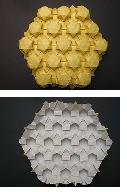
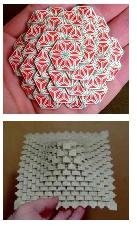
- learn to make an Origami Honeycomb by M Synnott
Don’t be fooled though, some models appear to be 3-dimensional but are actually flat models. This is seen in Eric Gjerde’s Spread Hex Tessellation. Here, hexagons are stacked so that the model has height due to the thickness of the paper but, it is actually a flat model. [Photo: E Gjerde’s Spread Hex Tessellation].
Fujimoto’s pyramid is also a flat model, but Joel Cooper used paper that was flexible enough that he could “stretch out” the model to appear 3 dimensional. A more traditional rendition of the same model is squished flat. [Photo: variation of Fujimoto’s pyramid folded by J Cooper]
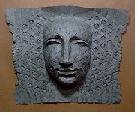

You can Tessellate Too
- fold Fujimoto’s Hydrangea
- buy Origami Tessellations
book by E Gjerde
- Tessellation Basics by E Gjerde (free download)
- Paper Mosaics e-book by A Bateman
More Information
- Alex Bateman’s Paper Mosaics site.
- Eric Gjerde’s musings.
- Andy Wilson’s web site.
- Tom Hull’s Geometrics and Tessellations.
- Chris Palmer’s Shadowfolds.
Tessellation Photos and Videos
- Flickr pool gallery here
- YouTube animated videos by T Tachi:
– Origami Animation Curved Folds
– Origami Animation “Ron Resch Pattern”
– Origami Animation Waterbomb Corrugation
– Origami Multi-Resolution MARS pattern - watch how to fold Half and Half (shown above, right) by R Schamp
- learn to make Shuzo Fujimoto’s Clover Folding by S Adams
- learn to fold Rose Tessellation by David_paperfold.
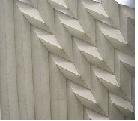
- TESS: by Eric Gjerdi and Alex Bateman. Generates origami tessellation diagrams.
- Interactive Tessellation Display by Robert Lang. An interactive demo that displays a tessellation and its folded form for a “Rings”-type tessellation. You can adjust several controls that affect the crease pattern and then see the results in the folded form in real time.

As mentioned above, an origami tessellation is not made from many pieces of origami placed side by site to form a tessellation. However, there is a category of origami which does use many pieces of origami linked together to form mosaics. It is called Origami Quilts.
Previous to this, Mick Guy had made many Escher-inspired origami composites where pieces are laid side by side like tiles on a counter top. These were different than the origami quilts mentioned above. Unfortunately, there are no photographs of Mick Guys work but you can read more about it from David Lister’s essay on tessellations.
- go to Origami Quilts
Books about Origami Tessellations
- Origami Tessellations: Awe-Inspiring Geometric Designs by Eric Gjerde
- Twists, Tilings, and Tessellations: Mathematical Methods for Geometric Origami by Robert J. Lang
- Origami Tessellations for Everyone: Original Designs by Ilan Garibi
- Six Simple Twists: The Pleat Pattern Approach to Origami Tessellation Design by Benjamin DiLeonardo-Parker
- Tessellation-Inspired Origami Box Designs by Arnold Tubis


